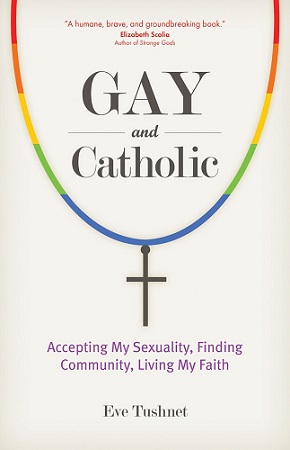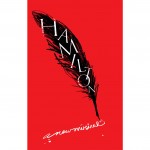Exciting news, everyone! Eve Tushnet’s first book, Gay and Catholic: Accepting My Sexuality, Finding Community, Living My Faith is out now!
First of all, if you’ve been spending any time reading the Synod relatio and all the breatheless commentary thereof, may I recommend that you try reading this book instead? Eve’s book is about one-third memoir and two-thirds thoughtful reflections on what vocations of self-gift and love make sense to offer to queer people (and other Catholics who are looking for a way to serve outside of marriage or monkhood).
To be honest, some of the most helpful parts of this book for me are simply the ideas she presents (explored through case studies, when she knows someone who fits the bill) of ways people have found to offer sacrificial love by choosing job/volunteer work carefully, living in intentional communities, exalting friendship, or practicing radical hospitality.
This is a book that’s important to plenty of people who don’t belong in either of the title’s categories. I’ll blog about it more soon.
In the meantime, while you wait for your copy to arrive in the mail, you can check out this interview Eve did with America.
When Eve isn’t writing interesting things about what she terms “Gay Catholic Whatnot” she does some excellent museum reviews. Which I think is segue enough to manage to link to an essay about Rembrandt next. I love good writing on classical art and music, because I’m not often drawn in on my own, but I can catch a sense of wonder if a writer is kind enough to lend me their eyes or ears. So this piece by Martin Gayford was a gift to me:
That familiar title, ‘The Jewish Bride’, was not Rembrandt’s; it first appeared in 1835, and with it a mistaken view that the scene was a contemporary one from the artist’s lifetime. In reality, as Jonathan Bikker, the research curator at the Rijksmuseum, pointed out to me as we stood in front of the picture, the story he was painting was a Biblical one, that of Isaac and Rebecca (or Rebekah). The two were married, but such was Rebecca’s beauty that Isaac — a refugee in Philistine lands — feared it would lead a Philistine to kill him, and marry her himself. Cautiously, he pretended that he was her brother. One day, however, ‘Abimelech, king of the Philistines, looked out at a window, and saw, and, behold, Isaac was sporting with Rebekah his wife.’ This is the incident that Rembrandt painted. But, characteristically, he omitted the figure of King Abimelech.
Consequently, we, rather than the Philistine king, become the witnesses of the couple, and what we see is the emotion between them. This is one of the most modern things about Rembrandt. ‘You don’t have to know all about the subject of the painting,’ Gregor Weber observed. ‘You feel straight away that it is about intimacy.’
Meanwhile, Nautilus informs me that composer Edward Elgar was a very clever cryptographer in his spare time.
In 1896, Schooling created a “Nihilist” cryptogam, a brief encrypted message, which he claimed no one would solve. In Nihilist cryptography, the encryption and decryption keys are the same; Russian Nihilists used the system against the tsar in the 1880s. Elgar stayed up one night and solved the puzzle, making notes on some sheet music for Cockaigne, his musical portrait of London.
Elgar was always fiddling with such things. His daughter’s name, Carice, combined letters of his wife’s first and middle names, Caroline and Alice. He gave violin and piano lessons to daughters of a local headmaster and used the letters in their last name, G-E-D-G-E, to create a musical cryptogram—a series of notes—and the motif for an allegretto. Incidentally, this particular bit of music is reminiscent of Robert Schumann, who was also drawn to ciphers and created elaborate cryptograms in pieces.
He left behind a ciphered message that still, to date, hasn’t been decrypted (though some of the attempts remind me of the worst excesses of the Baconians).
Which reminds me! If you’re in DC, you should be aware that the Folger Shakespeare Library has an exhibit on secret writing during the Renaissance that will be on display in November.
Meanwhile, Mormophis is doing a bit of an oblique reading of Lord of the Rings, and drawing out a hidden message about the dangers of the written word.
Tolkien’s ring of power is a plain gold ring, of course, and embodies a series of quite complex valences to do with binding, with vows and marriage. But at the same time as being a blank surface, the ring is also paradoxically (which is to say, magically) lettered. The ring, in other words, is a book. To be sure it is a short book; its whole text is the one ring charm. But a short book is still a book. Looked at this way, Lord of the Rings becomes a strangely self-destructive fable—a book about the quest to destroy a book, a long string of carefully chosen words positing a world in which words have magical power to huge evil. How few books there are in Middle Earth! Indeed, I’ve written elsewhere about not just the paucity of written texts in Tolkien’s world, but the way they keep getting misread. Gandalf scratches his rune at Weathertop; the hobbits misread it. The elven door in Moria, beautifully lettered, commands ‘speak friend and enter!’ and nobody understands its simple instruction. The fellowship find a dwarfish book in the mines, as scorched and battered as poor old Beowulf; but as they read it aloud (‘drums in the deep’, ‘we cannot get out’) it becomes true to them, and they repeat the words as suddenly, horribly, appropriate to their own predicament. The repeated theme is the danger of words; their slipperiness but also the ease with which they can move us directly into the malign world of the text. One ring to bind us all. Books are bound, too.
And while we’re on the theme of stealthy, dangerous acts, I really must recommend this story of The Man Who Smuggles Trader Joe’s into Canada. Seriously. Apparently many Canadians are sad not to have any Trader Joe’s in their part of the world, so this man overcame the bystander effect and… bought massive amounts of food at US Trader Joe’s, drove it across the border (doing all appropriate customs things) and then sold it at a markup in a shop that came to be known as “Pirate Joe’s.”
Hallatt says he loves new customers who show up visibly uneasy.
“There’s a hesitation like, ‘Am I going to get arrested?’” Hallatt said. It helps if there are a lot of holes in the shelves at the time. “Maybe somebody came and took all the damn mangoes or something. And we say, ‘We’ve got someone shopping right now, it’ll be back in a few days.’”
Hallatt seems to relish how the sloppiness of his store disrupts the normally transactional culture of buying groceries. “You usually walk into a grocery store thinking ‘OK I gotta get my stuff and get going, I’ve got two quarters in the meter.’”
“But Pirate Joe’s is a dangerous place to come into.”
“We try to give them a basket and they know what that means. If they grab a basket, they’re in trouble. So then we offer them chocolate.” Hallatt laughs, “The chocolate is usually a pretty effective icebreaker.” Eating chocolate, they’re comfortable enough to ask questions, and he tells them his story.
Also in the annals of seemingly absurd things that delight me immensely: look what sport I learned exists from a NYT article!
Breath control is the essential skill for success in kabaddi, a game with ancient roots in which teams take turns sending a raider across midcourt who, on a single breath, tries to tag a member of the opposing team and return safely to his team’s half of the court before taking another breath. To prove to officials that he or she is not inhaling, the raider must chant “kabaddi, kabaddi” throughout the attack. The best players can do it for several minutes.
I was travelling for Columbus Day, so I have not so much progress to report on the costume front. (I’m having a lot of trouble getting my computer to acknowledge the existence of my LilyPad USB, so I didn’t get the chance to try programming it).
To tide you over til next week, when I’d better have made some more impressive-looking progress, here’s the first awesome cosplay video to come out of New York Comic Con.
http://www.youtube.com/watch?v=OWmDPAHrtvI
I’m on Day 5 of a Novena to Mary, Undoer of Knots. Please feel free to join me!
For more Quick Takes, visit Conversion Diary!


















